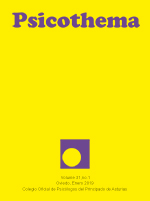Abstract
Background: The delimitation of the clinical high risk of psychosis (CHRp) is characterized by the wide variety of symptoms assessed from different approaches and the difficulty in detecting clinical stages that are a long way from the onset of psychosis. This study aimed to create a systematic procedure for an effective and accurate early detection of CHRp in educational settings. Method: A representative sample of 1,824 adolescents (average age, 15.79;
53.8%, women) was used to develop an online assessment system and a new 3-track, 3-level algorithm that combines symptoms of the main risk approaches: ultra-high risk (UHR), basic symptoms (BS), and anomalies in the subjective self-experience (ASE) with functional deficit. Results: The acceptability and feasibility of the online screening system were confirmed by the data. Of the total participants, 68 (3.7%) were identified as high-risk and 417 (22.9%) were identified as moderate, which also supports the functionality of the proposed algorithm. Conclusions: The system
indicates a dynamic model of progression of the different symptoms in the early stages of psychosis, and it may constitute a first line of identification for severe mental disorders in young people in the earliest stages, allowing application of initial preventive measures.
